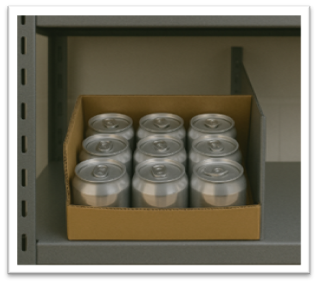.png)
Smarter restocking with Suggested Transfers...
May 20, 2025
In a busy warehouse environment, efficiency is everything.
From optimising storage to streamlining staff time, every process counts.
One area where many operations unknowingly waste time and space is restocking pick locations based on visual estimation, just “topping up by eye.” It feels intuitive, but in reality, it can hurt productivity and efficiency.
In this post, we’ll explore why that old method falls short and how StoreFeeder’s Suggested Transfers feature provides a smarter, data-driven alternative.
Lets start with a question...
Does this pick bin location need topping up, replenishing from bulk stock?

On first glance, you could not give an accurate or honest answer. It could be a yes, it could be a no. And this is what we are going to explore below.
The problem with visual restocking
Right now, many teams rely on simply looking at bins to decide whether to top them up from overflow areas. If a bin looks half-empty, someone may decide to refill it, regardless of actual need.
But here's the problem. Just because a bin isn’t full doesn’t mean it’s low on stock.
If a bin has 20 items and those are expected to last four weeks, then topping it up now is premature. That effort is wasted, and worse, the bin itself might be oversized relative to the product’s demand.
Why “Topping Up by Eye” Is inefficient
Restocking visually encourages habits that seem helpful but actually lead to:
- Overfilled pick bins for slow-moving products
- Wasted staff time on unnecessary top-ups
- Poor space utilisation in prime picking areas
A better approach is demand-driven: keep just enough stock (like 7 days' worth) in pick bins and store the rest in overflow areas. When the bin drops to a stock level of below 7 days worth of stock, top it up to the planned level.
Introducing suggested transfers
To address these inefficiencies, StoreFeeder offers Suggested Transfers, a smart feature that brings logic and sales data into your restocking process.
Here’s how it works:
- The system checks how many units of an item were sold in the last 7 days.
- If a pick bin has less than 7 days’ worth of stock, it will suggest a top-up.
- The system also recommends a quantity to bring the bin back up to 7 days’ stock—or more if you choose.
This ensures that restocking happens only when necessary, not when someone guesses it’s time.
How the suggested transfers workflow operates
When a pick location needs restocking:
- It appears on the Suggested Transfers page.
- You can convert it into a Pending Transfer and assign it to a team member.
- Once completed in the app, the transfer moves to Completed Transfers.
The data can be exported for further analysis, like identifying bins that need resizing.
This workflow not only saves time but also provides insights to optimise your warehouse layout.
Do you really need bigger pick bins?
The short answer: usually not.
As long as a pick bin can hold at least a week’s worth of stock, that’s all you need. Topping up more frequently or keeping bins full “just in case” often leads to clutter and inefficiency.
Instead, you should:
- Keep just 7 days of stock in pick bins
- Store extra stock in overflow areas, especially for slow-moving products
This method prioritises space for fast-moving goods and improves overall warehouse organisation.
Rethinking what “Low Stock” really means
Sometimes a bin may appear half-empty, but appearances can be deceiving.

Take this example: if you sell 3 units per week and the bin contains 9, that’s 3 weeks of stock. It’s not low, the bin is just oversized for the product’s sales volume.
Now imagine moving those same 9 units into a smaller bin.

Suddenly, it looks fully stocked, and it’s still 3 weeks of supply.
This demonstrates how right-sizing bins helps avoid unnecessary top-ups and confusion.
The Takeaway
Suggested Transfers changes the game by replacing guesswork with real data. Here’s what you gain:
- Fewer unnecessary top-ups
- Optimised use of prime pick space
- Reduced labour costs
- Smarter stock distribution
By trusting data over gut instinct, your warehouse runs leaner, faster, and smarter.
Stop asking, “Does this look low?” and start knowing for sure with Suggested Transfers.
